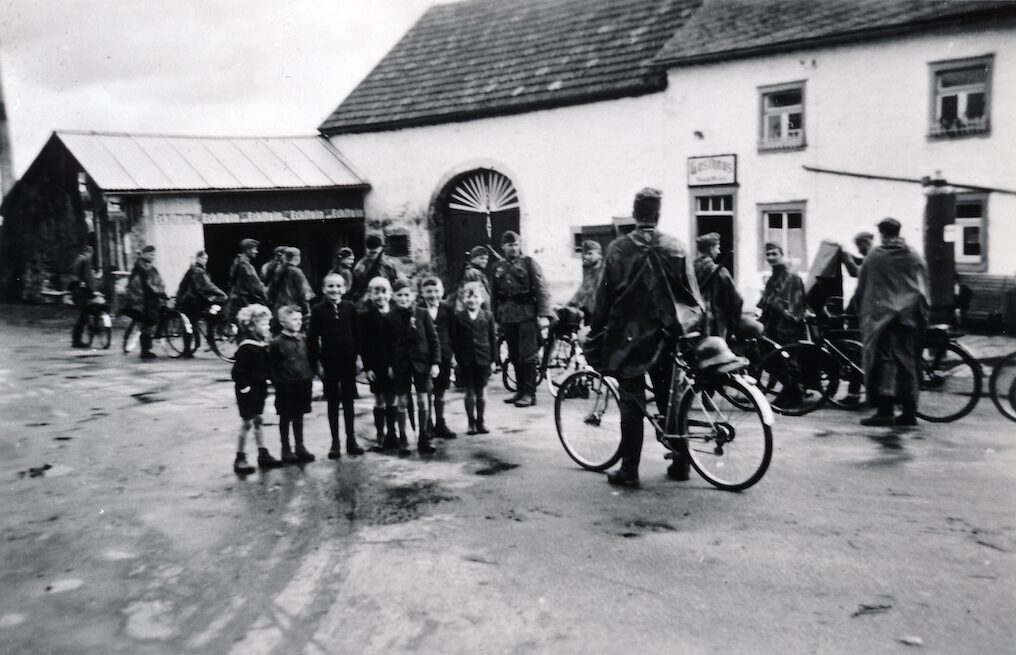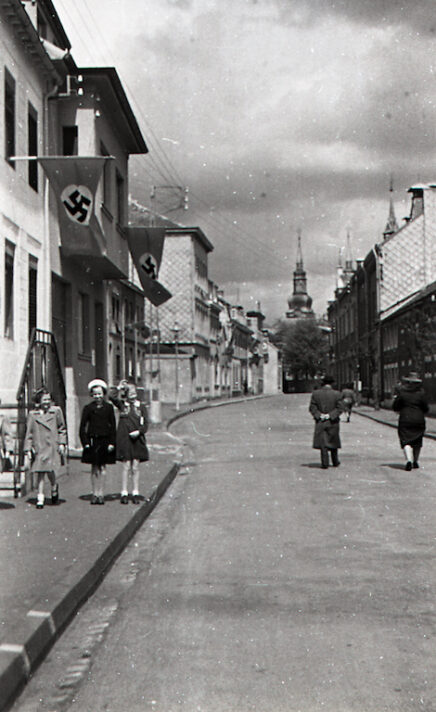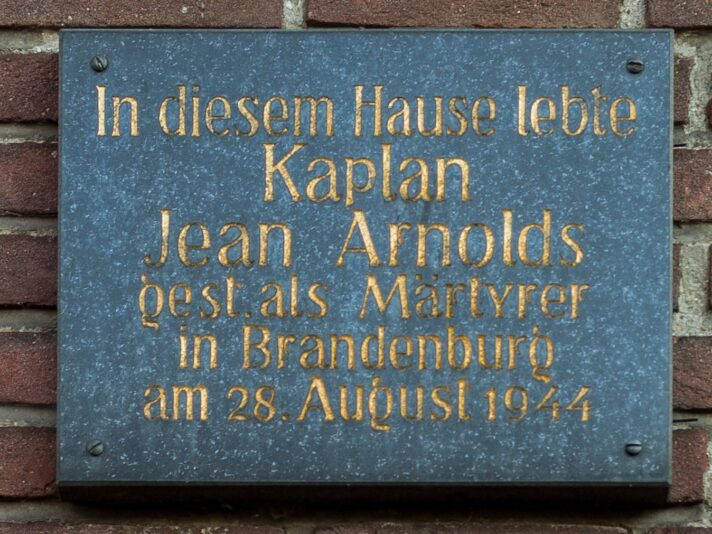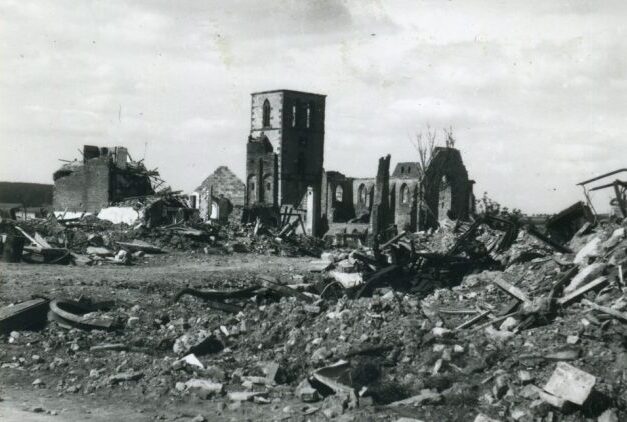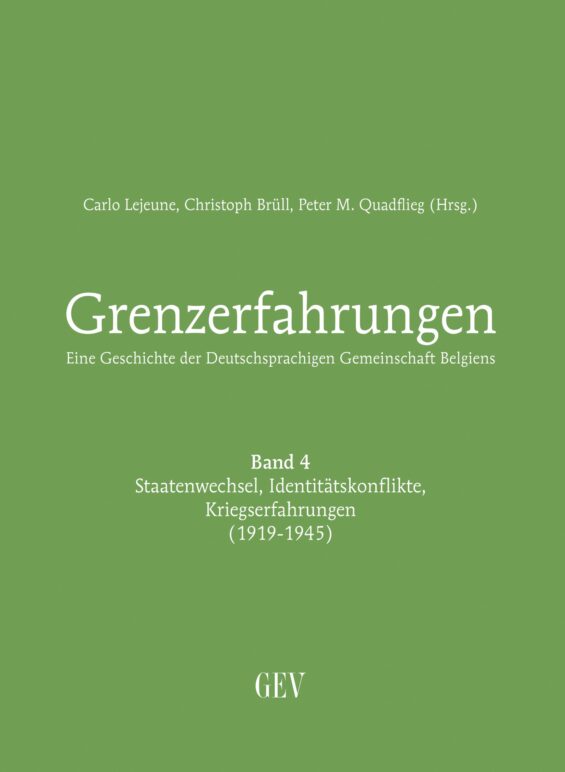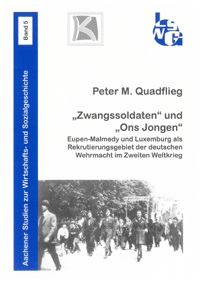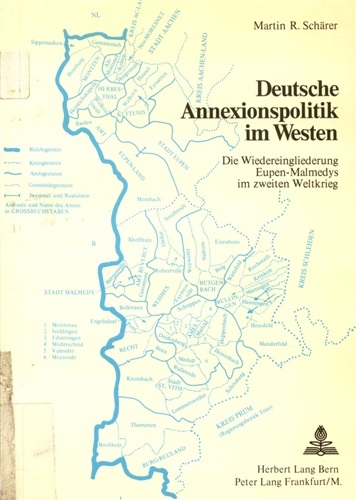-
On 10 May, the German Wehrmacht invaded Belgium. Second World War began in the West, the. While around 1.5 million people in Belgium, and opponents of the Nazi regime in eastern Belgium too, fled, many citizens between Kelmis and Ouren stood on the roadsides and cheered the German soldiers. Some presented small gifts (cigarettes, chocolate) and gave the Wehrmacht soldiers refreshments, such as water, coffee, raspberry juice, or a snack.
Why?
- Part of the population could not or did not want to settle in the new fatherland of Belgium. These citizens rejected the Treaty of Versailles and openly advocated a return to the old fatherland, Germany.
- The vast majority of citizens had still been socialised in Germany. National sentiment could not be changed in two decades.
- Some remained true to basic democratic convictions, others sympathised with the German dictatorship.
- The consequences of the world economic crisis seemed milder in Germany than in Belgium, which the Nazis exploited for propaganda purposes.
- In East Belgium, many pro-German organisations had campaigned for returning to Germany. They had been supported financially and ideologically by the Weimar Republic and, from 1933, by the Nazis.
- Around a hundred men had founded organisations acting as fronts for the National Socialist cause, openly promoting the ‘Third Reich’.
Was the majority of the population cheering on 10 May 1940? This question can hardly be answered in retrospect. Ego documents show that reactions ranged between ‘tremendous enthusiasm and boundless dismay – and all the shades in between,’ as Martin Schärer analysed. Hundreds of East Belgians fled inland. Probably few could have imagined the extent of the world war.
On 18 May 1940, the cantons of Eupen, Malmedy and Sankt Vith as well as ten ‘old’ (ie hitherto Belgian yet partly or largely Germanophone) municipalities were annexed by the ‘Third Reich’ by decree of the ‘Führer’. This annexation was illegal under international law as it had taken place before a peace agreement. In September 1941, a German law finally settled the citizenship question. From that moment on, the inhabitants of the annexed communities were full citizens of the ‘Third Reich’ with all the rights and duties. This included, for example, compulsory membership in certain Nazi organisations (such as the Hitler Youth or the Bund deutscher Mädel) as well as conscription into the Reich Labour Service (RAD) and the Wehrmacht. The citizens of Eupen-Malmedy-Sankt Vith thus lived under fundamentally different conditions than the citizens of occupied Belgium. The Belgian government in exile only protested against the annexation towards the end of the war.
The exuberant initial enthusiasm quickly gave way relatively to disillusionment. Did many citizens from the cantons of Eupen, Malmedy and Sankt Vith have an idealised image of their old fatherland? Did their German-national convictions cover up the reality of the German dictatorship? Could the citizens of this rural and poorly educated region have exposed Nazi propaganda better than, for example, the more than 90 percent of Saarlanders who voted for Germany – and hence, for the ‘Third Reich’ – in a referendum in 1935?
It soon became clear that the totalitarian state made its demands and demanded full commitment. The party, administration and propaganda strove to inspire the population for the ‘Third Reich’ in various ways. The party and the administration scrupulously covered up everything that could somehow be seen as a step backwards compared to when the region had been part of Belgium, e.g. deteriorating standards of living, or the slowdown in the establishment of telephone connections. Conversely, the Nazis loudly emphasised improvements.
However, the dictatorship had already snubbed the Catholic conservative population in June and September 1940 by taking down the crosses in schools, which had led to strong reactions. But there were no public protests. Why? A dictatorship, unlike a democracy, does not allow free actions in public. The dictatorship seeks to control and direct everyone’s life in its entirety. In a democracy, on the other hand, citizens can act freely and openly stand up for both their own rights and those of others. The right to liberty and the pursuit of happiness does not exist in a dictatorship. It grants the security of its citizens from denunciation, oppression, surveillance, persecution by the state, or even life itself only so far as it appears convenient to those in power. In dictatorships, citizens have no possibility of taking action against the state by democratic means. The only alternative consists in active resistance by individuals or groups (often at a high price). There is no evidence of organised resistance in the former ‘Eupen-Malmedy’. East Belgians who became active in this sense joined existing networks in Belgium. Some were also active in Germany. In total, more than 60 citizens from the annexed territories were killed as resistance fighters in concentration camps or prisons.
The German annexation policy in East Belgium can be divided into three stages: Reconstruction – Stagnation – Total War.
A first phase from May 1940 to autumn 1942 was characterised by astonishing activity despite the war. Large subsidies from the Reich supported the ‘reconstruction work’ in the ‘returned Eupen-Malmedy’. The money was not so much invested into buildings but into setting up and strengthening National Socialist organisations. The population was thus given the feeling of being part of a new, large national community. Every single person was registered and integrated into the system. This was meant to give people a sense of usefulness and shared responsibility.
The second phase lasted from autumn 1942 to May 1944 and was marked by deep disillusionment. Many projects came to a standstill, such as the continued construction of the Eupen Weser Dam, which had been started in 1936. Increased conscription of men and women into the RAD and the Wehrmacht, rising numbers of casualties, the German defeat at Stalingrad, ever tighter surveillance by the Gestapo and the SD (Sicherheitsdienst, the ‘security service’ of the SS), deportation of fellow citizens to prisons and concentration camps – all this fundamentally changed the mood.
The third phase from May 1944 to September 1944 was finally marked by measures of total war: full deployment for the war industry, increased conscription, increased use of women, tightened political surveillance.
By August 1944, 8,700 men from Eupen-Malmedy had been drafted. Around 3,300 of them were killed or remained missing.
In September 1944, the U.S. Army liberated the region, which had previously seen only sporadic bombing by Allied planes. In December, however, the Belgian Eifel and the Ardennes became the theatre of war in the Ardennes Offensive, known Battle of the Bulge in English. Some villages as well as the towns of Sankt Vith and Malmedy were almost completely destroyed, while the other towns were badly affected. These traumatic experiences of the civilian population have burnt themselves into the communicative memory of the region.
The Second World War plays a major role in the culture of remembrance in East Belgium, and it has strongly shaped the identity of the inhabitants. In the Belgian Eifel region in particular, a form of victimological memory developed, suppressing and covering less ‘convenient’ aspects. Yet, since the 1980s, a more active remembrance of the war and interwar period, with all the tensions they entailed, has also become possible. Historical taboos began to fall. In the Eupen region, this process took place much later.
After an initial phase of silence, the interest of historians in this period emerged in the mid-1960s – but not in the region itself. The young historical societies in Sankt Vith, Eupen, and Kelmis remained silent about this period from the beginning – with the exception of the Battle ot the Bulge. Instead, German and Swiss historians such as Klaus Pabst, Heinz Doepgen, Martin Schärer, and Heidi Christmann began researching periods such when the area changed states in 1920, 1940, and 1945, as well as the interwar and wartime periods.
Gradually, however, the media in the area also took a greater interest in the topic: book reviews, some of them quite long, were published in the Grenz-Echo. The German-language Belgian Radio station (Belgischer Hörfunk, BHF) began broadcasting the first documentaries. Since the 1980s, the many taboos surrounding National Socialist occupation have fallen.
The essence of a dictatorship is injustice and arbitrariness. Human rights are suppressed. Many suffer as a result. What does this look like in the 21st century? What thoughts arise when in Turkey the state is gradually transformed and people are deprived of the possibility to stand up for their rights? What about developments in Poland or Hungary, where fundamentally enshrined democratic principles such as the separation of courts and government, or freedom of the press are being curtailed? These instruments should serve to protect every citizen from an unjust state. What is the situation in Russia?
How should we assess the development in Belgium or other European states, where human rights have also been restricted in recent decades in order to increase the supposed security against terrorist attacks and a pandemic? Do cameras really need to be hung in a small town like Eupen to combat the allegedly high crime rate, or doesn’t everyone want to live in unobserved freedom?
-
Second World War
Second World War: 4,000 dead from East Belgium
Annexation by the Third Reich
Annexation by the Third Reich (18/05/1940)
Incorporation into the Third Reich
German currency, German prices and tariffs, German consumption regulations and market organisation are introduced (01/07/1940)
Invasion of the German Wehrmacht
Invasion of the German Wehrmacht (10/05/1940)
German citizenship
The inhabitants of the old Prussian districts of Eupen-Malmedy and Neutral Moresnets receive German citizenship automatically (retroactively on 23/09/1941) and without formality as of 18 May 1940 (23/09/1941).
Conscription into the Wehrmacht
War economy
Battle of the Bulge
Start of the Battle of the Bulge (16/12/1944 – 02/02/1945)
Flight
Wartime flight of East Belgians to Germany and Belgium
Émissions en langue allemande
Belgian radio programmes in German
Homecoming
Prisoners of war return home
-
-
![grenzerfahrungen-band4]() Carlo Lejeune, Christoph Brüll, Peter M. Quadflieg (eds.)
Carlo Lejeune, Christoph Brüll, Peter M. Quadflieg (eds.)Grenzerfahrungen. Eine Geschichte der Deutschsprachigen Gemeinschaft Belgiens.
vol. 4: Staatenwechsel, Identitätskonflikte, Kriegserfahrungen (1919-1945), Eupen 2018.
-
![ons jongen]() Peter M. Quadflieg
Peter M. Quadflieg„Zwangssoldaten“ und „Ons Jongen“.
Eupen-Malmedy und Luxemburg als Rekrutierungsgebiet der deutschen Wehrmacht im Zweiten Weltkrieg. Aachen 2008.
-
![schärer]() Martin Schärer
Martin SchärerDeutsche Annexionspolitik im Westen.
Die Wiedereingliederung Eupen-Malmedys im Zweiten Weltkrieg. Bern, Frankfurt am Main 1975.
-
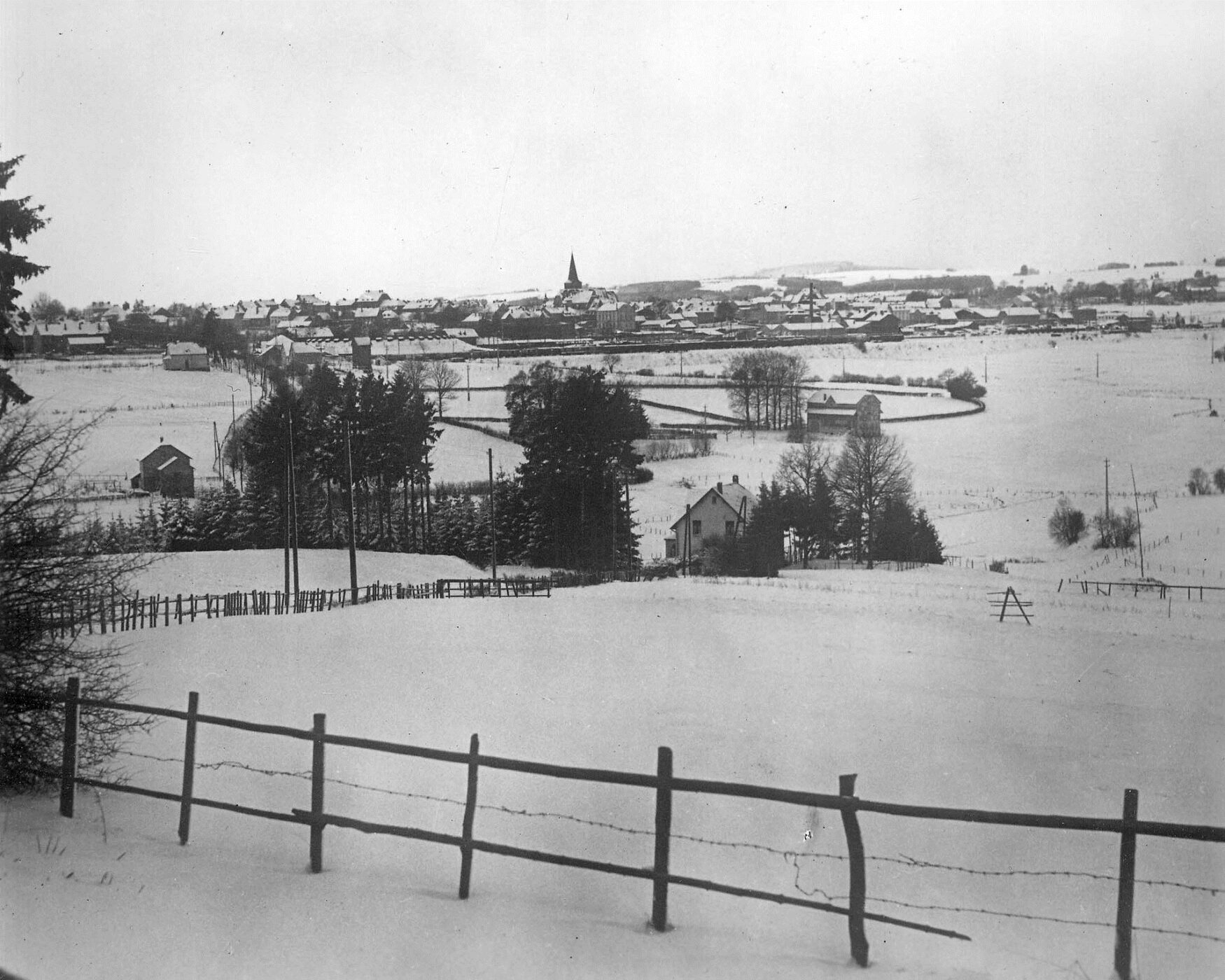
1939-1945
Second World War
Why bother with the National Socialist dictatorship in East Belgium during the Second World War? Those who live in peace in a democracy today have basic human rights from birth. Outside Europe, however, many democracies are being transformed into dictatorships. The history of the Second World War exhibits how life changed under a dictatorship, and that it is worthwhile to resist any dictatorship. The history of Eupen-Malmedy-Sankt Vith in the Second World War exemplifies how in a regime of injustice the individual has no rights, and that democracy is the best form of coexistence, despite its shortcomings.
